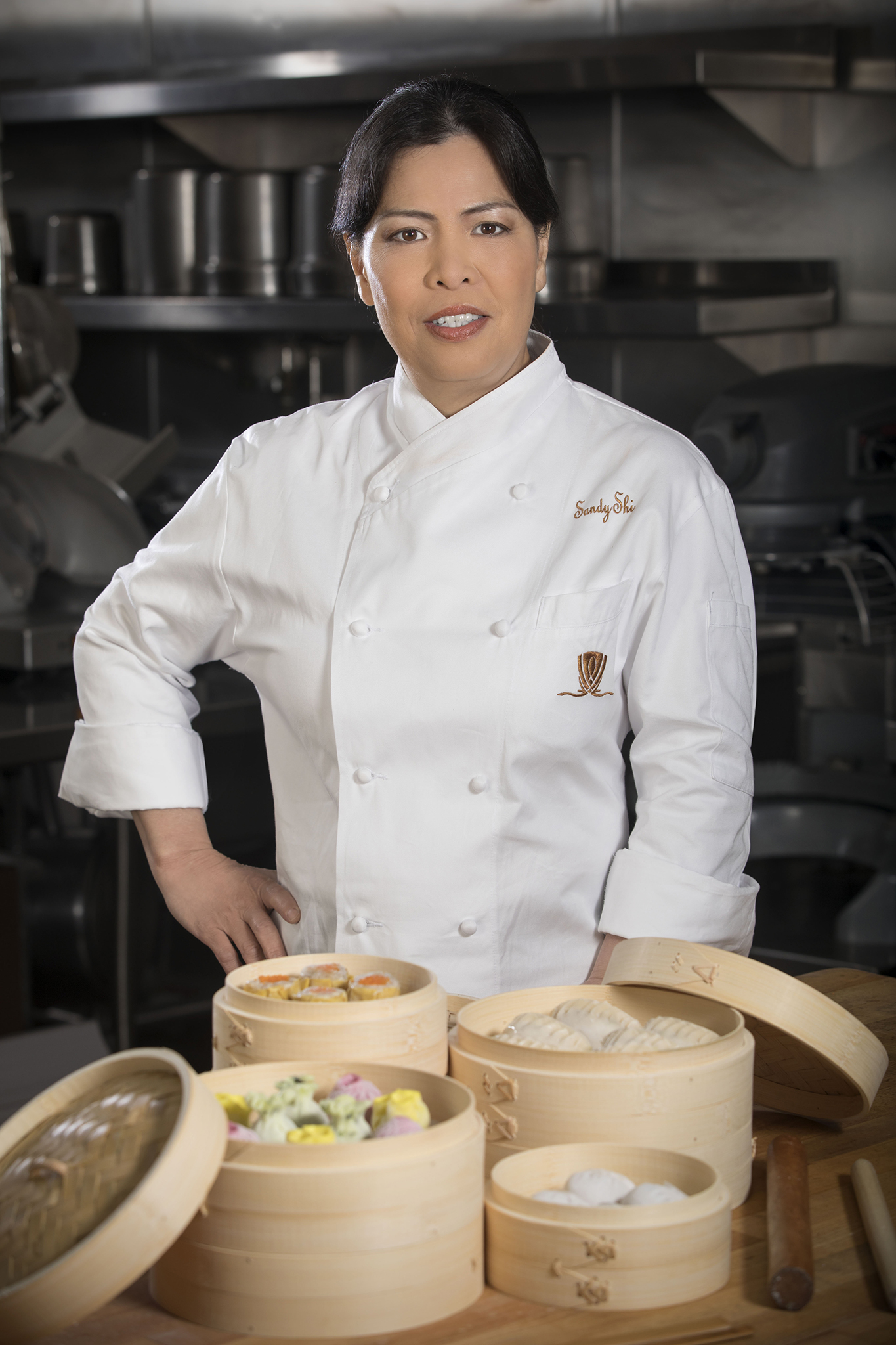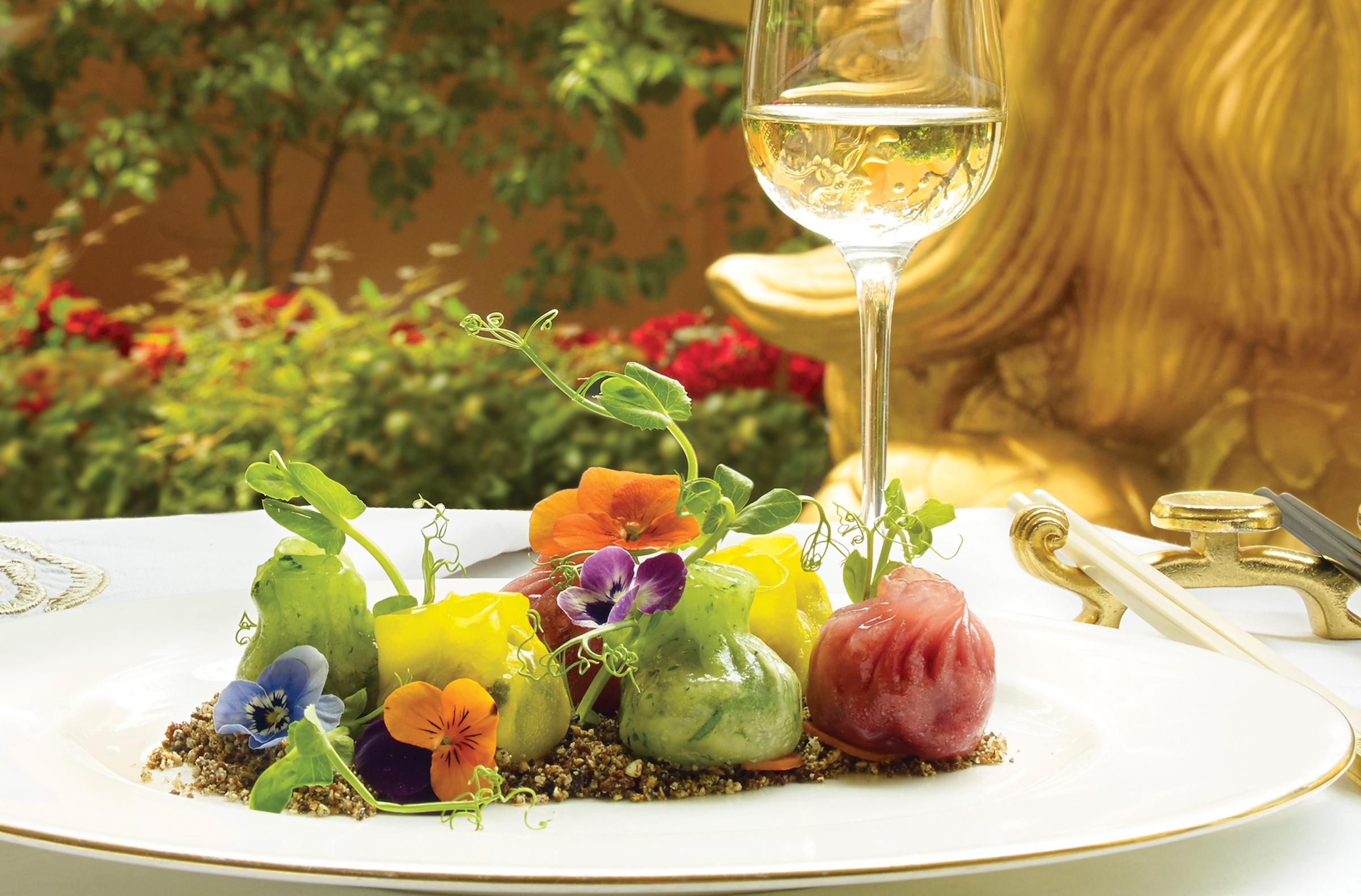
Scalding hot liquid bursting out of soup dumplings punctuated with the sharp taste of soy-vinegar sauce. The smell of barbecued pork wafting out after the first bite into a fluffy, white bun. Tender pieces of Peking duck with crispy skin. The sweetness of red bean paste inside a chewy sesame rice ball.
Dim sum is a feast of textures and flavors consumed to the cadences of Cantonese, clinking plates and squeaky wheels as servers push hand carts from table to table.
It’s also more than just a meal of Chinese cuisine; it’s meant to be a communal experience that can span hours, says Sandy Shi, executive dim sum chef at the Wynn Las Vegas hotel. In her native Hong Kong, where she started working in hotel kitchens after graduating from college, it’s customary for big groups to leisurely enjoy simple dishes together as a social activity.
“People go to restaurants early, around 10 a.m., and they don’t order a whole table of food. They order little by little and have a cup of tea and read the newspaper while they wait for the friends and family to join them,” the chef says. A visit to a dim sum restaurant can go well into the afternoon.
There are some who go to dim sum restaurants every day. “For some people in Hong Kong, dim sum is a daily routine,” Shi says. “It is a way of life.”

When Shi immigrated to the U.S. in 1993 and began cooking at dim sum restaurants in San Francisco, however, she noticed a difference in the way American diners approached the Cantonese cuisine: in the U.S., the focus is on the food.
Without the cultural emphasis on dim sum as a communal event to add context to her cooking, Shi had to learn how to transform traditional dishes to suit the American palate—which she found to mean more seasoning and stronger flavors. She took this lesson to heart when she became executive dim sum chef for all of the Asian restaurants at Wynn Las Vegas in the late 2000s. During her 11-year career at the luxury hotel and casino, Shi and her staff of seven have been responsible for executing the daily dim sum orders at Wing Lei, the first Chinese restaurant in North America to receive a Michelin star, as well as Mizumi, Red 8 and Wazuzu.
The chef and her crew churn out dim sum classics such as har gow (shrimp dumplings) and siu mai (pork-and-dried-oyster dumplings). But fine-dining crowds with a penchant for flavorful and visually pleasing food are looking for more than just traditional fare, Shi says. So now, she is constantly seeking ways to be more creative without sacrificing taste.
In Hong Kong, Shi was accustomed to cooking with ingredients delivered fresh every morning; but in her current kitchen, located in the Mojave Desert, she has to incorporate packaged ingredients and “tweak [her] recipes in order to make sure everything tastes the same.”
Those efforts have led to the reinvention of some classic dim sum dishes. Crispy garlic shrimp spring rolls are served with three dipping sauces: two with traditional flavors—hoisin and hawthorn—and a French-influenced Dijon mustard crème fraîche. Soup dumplings are upgraded with black truffle shavings, micro chives and an emulsion of Chinese superior stock, a rich broth commonly brewed from chicken, ham and pork.
Shi has also had to adapt to trends in American dietary habits, including a recent shift toward clean, nutritious and meat-free eating. For example, a creation of hers that has become a mainstay on the Wing Lei menu is the Garden Dim Sum, a vegetarian-friendly dish featuring colorful dumplings stuffed with spinach, beets and corn nestled on top of a nut-and bread-based “soil” and elegantly decorated with edible flowers and pea tendrils.

While Shi works hard to tailor her menu items to the preferences of her guests, she also makes sure her cooking keeps up with dim sum trends by regularly traveling around the world to see what other chefs in the industry are creating. But one particular trend she has noticed has nothing to do with the food. “There are more and more women getting in the industry,” Shi says. “Compared to other parts of the kitchen, dim sum has more women chefs.”
From the chef’s personal experience, the reason for this is simple: Women have smaller hands that are more suitable for the intricate hand-work dim sum requires. “Since everything is handmade, we can make things more delicate and detailed,” she says. And as a veteran with a career spanning over 25 years, her hands are more than up to the task.
How to Order Dim Sum
Whether you’re a newcomer to dim sum or an avid enthusiast, Shi has tips on how to find the best dim sum restaurants, and what to order when you get there:
1. Don’t go solo
Dim sum is traditionally meant to be experienced with a group. As a native Hongkonger, Shi sees the cuisine as a communal activity rather than just a meal. To her, “dim sum is an event for friends and family” where they gather in large numbers to leisurely enjoy simple dishes together.
Aside from the cultural significance, there’s a practical reason to eat dim sum with a large group: you get to try as many of the shareable bites as possible.
2. Hit up the classics
A newcomer to dim sum should try the essentials: har gow, or shrimp dumplings; siu mai, another style of dumpling typically made with pork and shrimp; and guo tie, or potstickers. These are fundamentals in a dim sum chef’s repertoire, Shi says, and you should avoid restaurants that mess up the basics.
A more advanced dim sum dish Shi suggests is fried shrimp balls. They are “particularly hard to make because they are crispy on the outside and have a hot broth on the inside.” If the restaurant nails this menu item, that means it has a skilled chef in the kitchen.
3. Dim sum and tea are meant to be
Drinking tea is an important part of the dim sum experience that you shouldn’t skip, says Shi. In fact, because the beverage has had a longstanding association with the cuisine, yum cha, which literally means “drink tea” in Cantonese, is used interchangeably with the phrase “dim sum.”
A goody dim sum place will offer a variety of high-quality teas, and provide information on their origins. “If a restaurant cares about their tea, then they must care about their ingredients,” Shi says.
4. Observe your surroundings
When you visit a dim sum spot, check out the bathroom and the general state of the dining room. If those areas are not clean, then that’s a good indicator that the kitchen is probably also not clean.
5. Beware of MSG
A lot of dim sum kitchens overload dishes with monosodium glutamate in order to mask the lack of freshness and poor quality of their ingredients. How can you tell if you ate something with MSG? “After the meal, you will be very very thirsty,” Shi says. “Also, if you can’t actually taste the real ingredients, whether it’s pork or shrimp, that means there is usually additives and seasoning.”
6. Check for seafood freshness
A truly great dim sum place will use fresh seafood. In Shi’s kitchen, she and her team make har gow with fresh, whole shrimp; lesser restaurants might try to hide that their shrimp is not fresh by mashing it up for the dumpling filling.
Additionally, lower-quality dim sum spots may not freshly wrap their dumplings, and then overcook them to hide that fact. One way to tell if a place is cutting corners is that its dumplings will break apart when you pick them up.
7. Take a trip
For serious fans, Shi recommends visiting two North American cities that chefs acknowledge as places for really good dim sum: San Francisco and Vancouver.
More Must-Reads from TIME
- Why Biden Dropped Out
- Ukraine’s Plan to Survive Trump
- The Rise of a New Kind of Parenting Guru
- The Chaos and Commotion of the RNC in Photos
- Why We All Have a Stake in Twisters’ Success
- 8 Eating Habits That Actually Improve Your Sleep
- Welcome to the Noah Lyles Olympics
- Get Our Paris Olympics Newsletter in Your Inbox
Contact us at letters@time.com